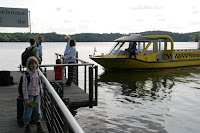Uppsala in Sweden is still one of the places I have never been to – and this year I missed another chance: Interact 2009
From our group Florian was there an presented his paper on a parasitic applications for the web [1]. We also published joined work with ETH Zürich on a comparison of product identification techniques on mobile devices [2]. Heiko Drewes has submitted his PhD thesis on Eye-tracking for interaction and one of the early projects he did was now published at Interact. The idea is that the mouse courser is positioned to the position where your eye-gaze is in the moment you touch the mouse [3]. Interact 2009 was quite competetive as it had an acceptance rate of 29% for research papers.
[1] Alt, F., Schmidt, A. Atterer, R., Holleis, P. 2009. Bringing Web 2.0 to the Old Web: A Platform for Parasitic Applications. Human-Computer Interaction – INTERACT 2009. 12th IFIP TC 13 International Conference, Uppsala, Sweden, August 24-28, 2009. Springer LNCS 5726. pp 405-418.
http://www.springerlink.com/content/vr175l725m7185m6/
[2] von Reischach, F., Michahelles, F.,Guinard, D.,Adelmann, R. Fleisch, E., Schmidt, A. 2009. An Evaluation of Product Identification Techniques for Mobile Phones. Human-Computer Interaction – INTERACT 2009. 12th IFIP TC 13 International Conference, Uppsala, Sweden, August 24-28, 2009. Springer LNCS 5726. pp 804-816
http://www.springerlink.com/content/740421515527855g/
[3] Drewes, H., Schmidt, A. 2009. The MAGIC Touch: Combining MAGIC-Pointing with a Touch-Sensitive Mouse. 2009. Human-Computer Interaction – INTERACT 2009. 12th IFIP TC 13 International Conference, Uppsala, Sweden, August 24-28, 2009. Part II. Springer LNCS 5727. pp 415-428
http://www.springerlink.com/content/m188522m6q5470l2/


















